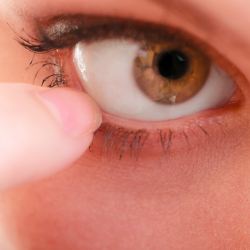
“What is that you express in your eyes? It seems to me more than all the print I have read in my life.” Well envisioned, Walt. Whitman, that is.
I won’t claim the follow-up to my first piece on foreign bodies in the body will be as eloquent, but it will affirm this sentiment: Preservation of vision should be a cherished, lifetime goal. So, let’s talk high velocity projectiles -or, their avoidance -chemical splashes, particle fragments, and creepy crawlers.
Whether occupationally, recreationally, or run-of-the-mill induced, ocular insult by inanimate objects can be catastrophic. Unlike other organs, periorbital damage has a critical cost. Our eyes subsume memories, capture still life and moving images, enhance our other senses, and absorb our stories. Our legacies. Those fortunate enough to retain the trait of sight should value the privilege.
We are going to start from the outside in, because that’s the way eyes are typically examined. The conjunctiva is the clear mucous membrane that covers the white part of the eye— it extends inside the upper and lower lids. An item can only go so far back, above or below given there is a catch preventing it from wandering behind the eyeball itself.
Between the eyelid and surface of the eye, trespassers may abound.
According to Dr. Lee Snyder, Johns Hopkins-trained cornea and refractive eye surgeon, ophthalmologists routinely remove gnats, parts of flies and other tiny insects embedded inside lids. The summer, in particular, is prime time for things that fly in the air to be carried by wind into the eye. Alive or dead. Inanimate or not. She frequently encounters dislodged contact lenses, particles of dirt, loose eyelashes, or even beads from facial exfoliants. Patients usually “feel like something is in the eye.” Once out, there is typically instant relief.
If the intruder is sharp enough to cause corneal abrasion, then there will be redness, pain, and even sensitivity to light. Early medical evaluation is the safest way to elude infection or vision loss. People tend to cause greater harm when they rub or attempt to remove interloper themselves. Common culprits of corneal abrasion —cheers to that alliteration— are walking into tree branches, fingernails from other players in basketball, pet scratches (dogs and cats mainly as usually present in households), and parents scratched by their curious infant or toddler.
Chemical splashes are routine as well. They can occur when people reach in the dark for something on their desk or nightstand. Superglue is a mainstay. As are ear drops. Nail glue when doing own nails and mistakenly touch the eye. Using products that contain lye, bleaches, and soaps —bases being worse than acids— can corrode through the eye and blind. The key in preventing injury is immediately to flush, flush, flush, and flush again with water while seeking emergency care.
The globe or eyeball is at risk of penetrating and blunt-force trauma. The former is plentiful when drilling, hammering, lawn mowing, or grinding metal in construction or home repair. Dr. Snyder insists, “Anything that can produce a small, high velocity projectile or particle warrants eye protection.” In her experience, the refrain with these wounds is “oh, I was just doing this quick thing and can’t see well with the goggles, so I…” This is when they get into trouble. The quick moments. Perforating injuries are through and throughs. When it comes to blunt force, fists, baseballs, and bungee cords are regular offenders. Such high energy recoil can rupture the eyeball. Fireworks can damage eyes with projectiles so hot they can actually melt ocular tissue.
Injuries with objects like screwdrivers are more likely to penetrate the globe than the orbit. But, it is true that if enough force is generated (car accident or assault with sharp object) a foreign object can injure the eye as well as the orbit, or can sometimes avoid the eye altogether and injure tissues and bones around it.
The bony orbit is beautifully designed to absorb shock serving as protective housing for the eye. While balls that are similar in size to eyeballs can fit through this bony encasement and severely damage the eye (golf, squash, or paintballs, for example), objects that are much larger have more of a chance of injuring the bony orbit. Contact with large foreign objects such as in motor vehicle accidents, sports like baseball, or assaults with a fist can break walls of this area.
Phew… Sigh… Ugh… Yes, use protective eyewear. Yes, be quick to seek professional treatment. Keep that tetanus vaccine status current and know when to flush, flush, flush with water. All purposeful tasks in this injurious realm. Learn the lessons now.
Join me for my next installment of “Inanimate Objects in Orifices” as we work our way down the body. The chest and abdomen are in your near future.
